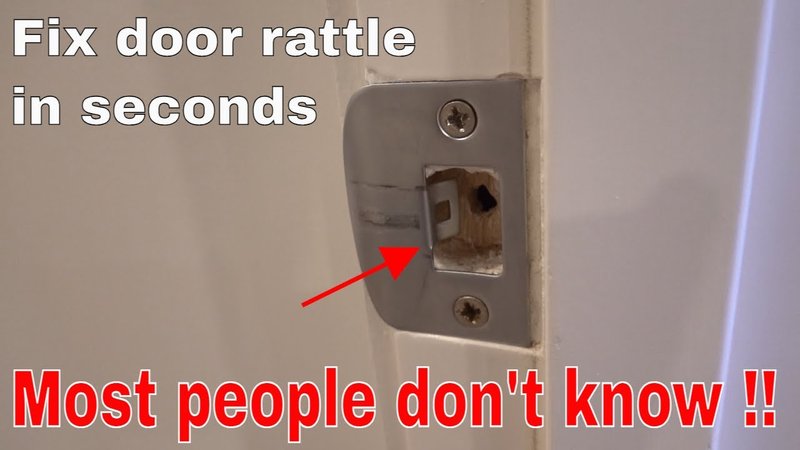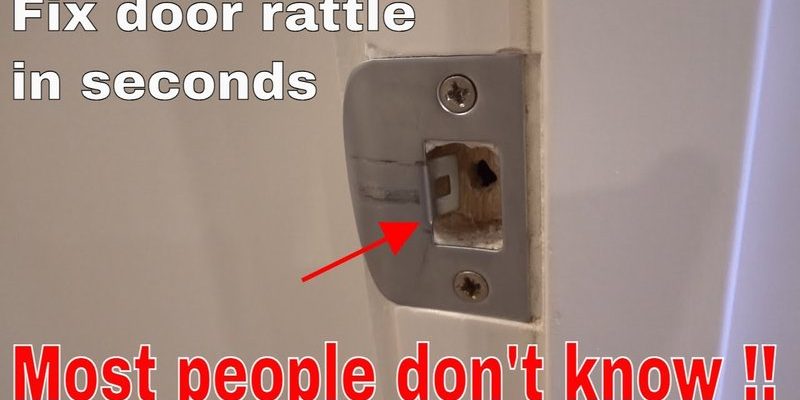
When a door rattles, it often indicates an underlying issue. This could be anything from loose hinges to a misaligned frame. If you’ve experienced a rattling door before, you know how distracting it can be, especially if you’re trying to enjoy some peace and quiet at home. Plus, considering that doors are one of the main barriers to outside noise, fixing this issue can significantly elevate your comfort at home.
In this guide, we’ll explore the common causes of a rattling door and how to troubleshoot them. So, grab a cup of coffee, and let’s dive into this together!
Understanding the Rattle: What Causes It?
Before we get into the nitty-gritty of diagnosing a rattling door, let’s understand what causes this common issue. Doors might rattle for various reasons, and identifying the cause is crucial for finding a solution. Here are a few potential culprits:
- Loose Hinges: Over time, hinges can become loose due to regular use. When this happens, the door may jiggle when closed, creating that annoying rattle.
- Misaligned Frame: If the door isn’t perfectly aligned in its frame, it may not close all the way, allowing gaps that cause noise.
- Weatherstripping Issues: Worn or missing weatherstripping can create space in the door’s closure, leading to rattling sounds.
- Wind or Drafts: Sometimes, outside factors like wind can push against the door, making it rattle as it moves slightly.
Understanding these causes sets the stage for diagnosing your specific problem. It’s like part of solving a mystery—knowing what you’re dealing with makes it much easier to fix!
Step 1: Check the Hinges
The first step in diagnosing a rattling door is to inspect the hinges. Loose hinges are often the main offender when it comes to rattling. Here’s how to check them:
1. Visual Inspection: Look closely at the hinges. Are they firmly attached to both the door and the frame? If you notice gaps or the screws appear to be loose, that’s a sign.
2. Tighten the Screws: Using a screwdriver, tighten any loose screws in the hinges. Sometimes, simply tightening can solve the issue.
3. Lubrication: If the hinges look fine but still rattle, it might be worth applying some lubricant. A few drops of oil can help the hinge operate more smoothly.
If the rattling persists after this step, it may be time to check the door frame.
Step 2: Assess the Door Frame Alignment
If the hinges are secure but the noise remains, it’s worth checking if the door is properly aligned within its frame. A misaligned door can lead to gaps or uneven closures. Here’s what to do:
– Examine the Fit: Close the door slowly and watch for any uneven gaps along the edges. If it appears to be hanging slightly lower on one side, it may need adjustment.
– Adjust the Hinges: Sometimes, you can fix alignment issues by shimming or adjusting the hinges. You may need to add thin washers under one hinge to lift the door slightly.
– Check for Warping: If the door is wooden, keep an eye out for warping. Extreme temperature changes or humidity can cause wood to swell or shrink, leading to misalignment.
Recognizing door frame issues is crucial since it may require a bit more work to adjust properly.
Step 3: Inspect Weatherstripping
Old or damaged weatherstripping can also be a culprit in a rattling door. This material helps seal the gaps around the door and reduces drafts. Here’s how you can check it:
– Look for Damage: Inspect the weatherstripping around the door frame. If it’s cracked or missing pieces, it won’t create a tight seal, which can lead to rattling.
– Replace if Necessary: Replacing weatherstripping is often straightforward. Simply peel off the old strip and apply a new one that fits snugly. Many hardware stores offer different types, so choose one that works best for your door.
– Test the Fit: After replacing it, gently close the door to check if the rattling persists. A proper seal should significantly reduce movement and noise.
Taking care of weatherstripping is an easy DIY fix that can make a big difference.
Step 4: Evaluate External Factors
Sometimes, the source of a rattling door can be external. Factors like wind or drafts can cause doors to rattle even when they’re closed. Here’s what to consider:
– Wind Direction: Pay attention to the wind direction. If strong winds are blowing against your door, it may cause some movement.
– Draft Stoppers: If you live in a windy area, consider using a draft stopper or door sweep. This can help keep the door sealed more effectively against outside forces.
– Window Consideration: Ensure that nearby windows are tightly secured. If they are flapping or rattling, they can create an overall noisy environment, which can make your door sound even louder.
By examining these factors, you may find that the noise isn’t just the door itself but rather the environment around it.
Step 5: Test for Closure and Latch Issues
Finally, ensure that the door closes properly and that the latch is functioning correctly. A faulty latch can cause the door to rattle even if everything else seems fine. Here’s how to check:
– Close the Door Slowly: Listen carefully as you close it. Does it latch securely? If not, it could be misaligned, which may require adjustment.
– Adjust the Strike Plate: Sometimes, moving the strike plate slightly can help the latch catch better when closed. You can do this by loosening the screws, adjusting the plate, and tightening it back into place.
– Look for Wear and Tear: Inspect the latch itself. If it’s rusty or damaged, it may be a good idea to replace it to ensure a snug fit.
Getting the door to close and latch properly can resolve unwanted rattling problems effectively.
Diagnosing a rattling door might seem challenging, but by following these steps, you can easily identify and fix the problem. Whether it’s tightening hinges, realigning the frame, or addressing weatherstripping, each step brings you closer to a quieter home. Remember, doors play a vital role in our comfort and peace of mind. A little detective work can make a world of difference in your living space.
So, next time you hear that annoying rattle, take a moment to pinpoint the source. With a bit of patience and a few tools, you’ll be able to put your detective skills to good use—and enjoy the calm you deserve.
